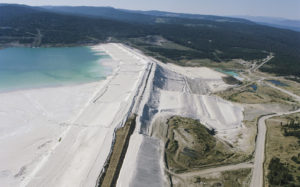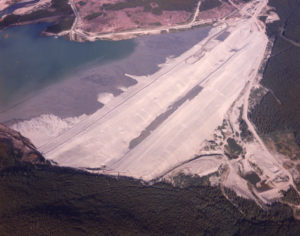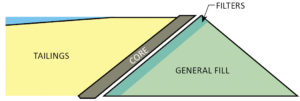History of Tailings Dam Design
May 19, 2020 |
Tailings dam construction has evolved and improved over the past several decades. Klohn Crippen Berger (and its predecessor companies) helped to revolutionize the design of modern tailings storage facilities 50 years ago, and our engineering approach continues to be the hallmark of international practice. Today, we provide solutions for some of the largest, technically challenging tailings storage facilities in the world.
In the early days, tailings were simply disposed of in local rivers and streams. It was only in the 1960s when the first tailings dams were built. Today, other technologies such as filtered tailings and co-disposal are being used around the world. Here is a timeline of tailings dam construction, as well as a brief overview of the three main types of tailings dam designs.
Early days – pre-1900
Historically, the only option for tailings storage was to deal with a tailings slurry. Tailings were disposed of in the most convenient manner, such as in rivers and streams. By about 1930, this type of tailings disposal was stopped in the western world, creating the first benchmark regulations on mine waste management. In a few areas of the world, tailings are still disposed of in waterways, especially areas that have high rainfall and steep, unstable terrain. However, this method of disposal is no longer common practice, mainly because of environmental concerns.
Pre-1960s
Up until the 1960s, tailings dam designs either used the upstream dam construction method or conventional water storage dam designs to contain the tailings. An early photo of upstream dam construction is shown in Figure 1.

(Image source: A Dedicated Team, Leonoff, 1994)
1960s
Cycloning of tailings was developed in the 1960s and continues to be a major component of tailings dams (McLeod and Bjelkevik, 2017). In 1962, cycloned tailings for dam construction was first adopted on the Zambian Copperbelt, with the construction of the Lubengele Dam.
In the mid 1960s, Earle Klohn, one of the founders of Klohn Crippen Berger, pioneered the design of centerline cycloned sand dams (see Figure 2 below). This was one of the first engineered tailings dam designs in the world. The design was based on the sound principles of soil mechanics and still, to this day, meets seismic criteria for high dams. The Brenda Mine tailings dam in British Columbia is the first centerline cycloned sand dam in the world (see Figure 3 below).


(Image source: A Dedicated Team, Leonoff, 1994)
In an almost prescient quotation, Earle Klohn stated the following in an address to the University of Missouri in 1977:
“There would appear to be no doubt but that in the very near future, all tailings dams will be designed and constructed using sound engineering principles based on conventional water storage dam design technology. Moreover, the design and construction of tailings dams will be closely controlled by both state and federal agencies. The added cost associated with satisfying such regulations, must, in the future, be considered as part of the cost of developing the mine.” (McLeod et al. 2015)
1970s
During the 1970s, the number of tailings dams in Canada and worldwide started to significantly increase with the expansion of the mining industry. The heights of tailings dams started to exceed 300 m.
The upstream method of tailings dam construction started to be replaced by the centerline and downstream methods “using cyclone sand embankments, blanketed upstream by spigotted slimes” (Klohn & Maartman, 1972). Downstream and centerline methods resulted in safer tailings dams, especially in seismically active regions. In addition, the mining industry and government regulators were becoming more aware of the need for better and safer tailings dams “to meet basic requirements of safety and pollution control” (Klohn & Maartman, 1972).
1980s and 1990s
The use of filtered tailings became more popular in the 1980s. However, significant equipment and operational costs (mainly power consumption) made the filtering of tailings not feasible for most operations (McLeod and Bjelkevik, 2017). With improvements in the efficiency of filtering equipment, the interest towards tailings filtering has increased in recent years.
Thickening has been used to improve water recovery from tailings streams since the mid-1990s. Thickening the tailings slurry as part of the process plant operation using conventional thickeners has become a common practice over the last few decades (McLeod and Bjelkevik, 2017).
2000s
The recent practice of sulphide separation with a flotation circuit in the process plant can produce a tailings product with a low acid rock drainage potential (McLeod and Bjelkevik, 2017). Co-disposal, the placement of acidic mine waste rock with tailings, has gained increased acceptance. Integration of tailings with mine waste rock is important and can be used to reduce costs and risks. Other technologies reduce evaporation losses, for example the use of cells in arid climates to limit the evaporation losses from the wetted beach surfaces (McLeod and Bjelkevik, 2017).
Types of Tailings Dam Designs
Upstream
Upstream construction involves a “starter” dyke which is raised as the pond is filled. The tailings are discharged by spigotting from the top of the starter dyke.

Downstream
Earle Klohn (1971) mentioned that engineering knowledge and experience must be blended with mining operators’ knowledge to develop economically feasible solutions. “One of the first results of blending of knowledge was the development of the downstream method of dam building” (Klohn, 1971).
A downstream dam is built with sand fill, usually separated from tailings by cycloning. No tailings are mixed with the sand dam, as the dam is built in the downstream direction.

Centerline
Centerline dams are a variation of the downstream dam. In this case the central core zone is supported by the tailings and a localized zone of fill is placed on top of the tailings (McLeod and Bjelkevik, 2017).

References:
Klohn, E.J. 1971. “Design and Construction of Tailings Dams”. Presented at the Annual Western Meeting of the CIM, October 1971, Vancouver BC, CIM Transactions volume LXXV, pp. 50-66, 1972
Klohn & Maartman, 1972. “Construction of Sound Tailings Dams by Cycloning and Spigotting,” in Proceedings of the 1st International Tailing Symposium, October 31-November 3, 1972. Tucson, Arizona.
McLeod, H.N., B.D. Watts and H.D. Plewes. 2015. "Best Practices in Tailings Dam Design," in CIM 2015 Convention, Montreal, QC, May 10-13.
Leonoff, C. 1994. A Dedicated Team: Klohn Leonoff Consulting Engineers 1951-1991. Richmond, BC: Klohn Leonoff Ltd.
McLeod, H. and A. Bjelkevik. 2017. "Tailings Dam Design: Technology Update (ICOLD Bulletin)," in Proceedings of the 85th Annual Meeting of International Commission on Large Dams, July 3-7, 2017. Prague, Czech Republic: Czech National Committee on Large Dams.
Tailings.info http://www.tailings.info/basics/history.htm. Jon Engels
Wikipedia. https://en.wikipedia.org/wiki/Tailings
